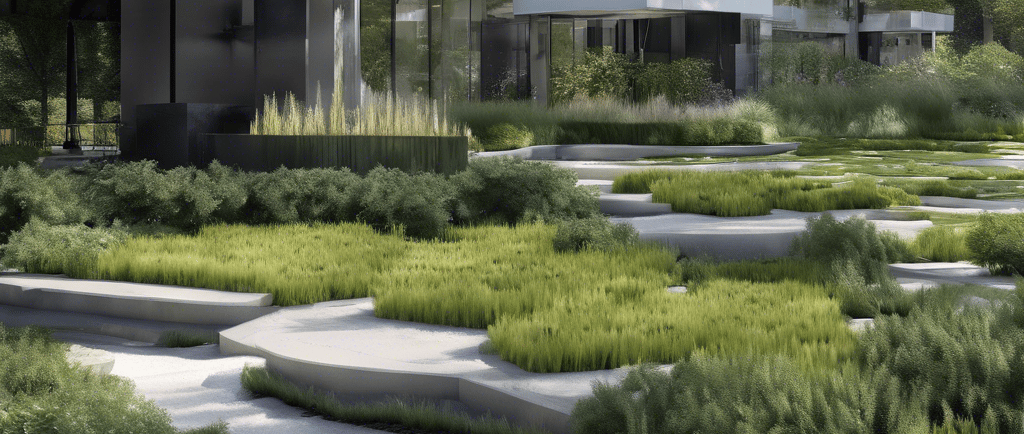The Elegance of Modern Landscape Design: Simplicity and Sophistication
Abyakta Landscape
8/9/20244 min read


Principles of Modern Landscape Design
Modern landscape design revolves around a core set of principles that emphasize clean lines, minimalism, and the seamless integration of natural and manufactured elements. Central to this design philosophy is the importance of balance and order, often achieved through the strategic use of geometric shapes. These shapes create structured and visually appealing environments, contributing to a sense of harmony in the space.
One of the defining characteristics of modern landscape design is its emphasis on simplicity. This approach often involves reducing clutter and focusing on essential elements, encouraging an uncluttered and serene aesthetic. The use of linear patterns, straight pathways, and unadorned surfaces helps maintain a clean and sophisticated look, fostering a feeling of calm and order.
The integration of natural elements with manufactured materials is another crucial principle. Modern landscape design skillfully combines elements like wood, stone, and metal with plant life to create spaces that are both aesthetically pleasing and functional. This juxtaposition of materials can highlight the beauty of each component, enhancing the overall visual impact of the design.
Sustainability and functionality are also prioritized in modern landscape design. This often involves the use of native plants, which are better adapted to the local climate and require less maintenance. Native plants not only support local ecosystems but also help create eco-friendly landscapes that are both beautiful and practical. In addition, modern landscapes often incorporate sustainable practices such as rainwater harvesting, xeriscaping, and the use of recycled materials.
Examples of modern landscape design in action include gardens with sleek, straight-edged water features, patios with minimalist furniture, and pathways bordered by native grasses. These elements work together to create spaces that are not only visually stunning but also highly functional and sustainable.
Materials and Elements in Modern Landscaping
Modern landscape design emphasizes the use of sustainable and low-maintenance materials that contribute to both the aesthetic appeal and longevity of outdoor spaces. Among these materials, concrete, steel, glass, and natural stone stand out for their durability and versatility. Concrete's sleek, industrial look makes it a staple in pathways, patios, and retaining walls, while it can also be formed into various shapes and textures to complement the modern aesthetic.
Steel, particularly corten steel, is favored for its contemporary and rusted finish that naturally blends with the surroundings. It is often used for planters, edging, and garden sculptures, providing a striking contrast to greenery. Glass, another essential component, brings transparency and lightness to the landscape. Used in fences, walls, and water features, glass integrates seamlessly with natural elements, enhancing reflections and views.
Natural stone, meanwhile, adds texture and authenticity. From gravel pathways to stone-clad walls and boulder accents, natural stone imbues the landscape with an organic yet refined touch. Its various forms and finishes combine functionality with an understated elegance.
In addition to these materials, modern landscapes often feature outdoor elements that extend living spaces and foster a connection with nature. Fire pits create focal points and gather people together, adding warmth and ambiance. Water features, such as minimalist fountains and reflecting pools, introduce tranquility and a sense of calm, while also offering visual interest.
Minimalist garden furniture, characterized by clean lines and functional designs, integrates effortlessly into modern landscapes. Seating areas are designed for comfort and style, making outdoor spaces inviting and usable year-round.
Lighting plays a pivotal role in modern landscape design, providing both functionality and mood. Well-placed fixtures highlight architectural features, pathways, and plantings, ensuring safety and enhancing the overall ambience. LED technology and solar-powered lights offer energy-efficient solutions suitable for various needs, making lighting an integral component in the harmony of modern landscaping.
Design Tips and Inspiration for Your Modern Landscape
Jumpstarting a modern landscape design project requires a thoughtful approach to planning and execution. Embrace the elegance of simplicity by starting with a clear vision. Begin by selecting a central theme or focal point that aligns with both the architecture of your home and the surrounding natural environment. This harmonious integration is fundamental to achieving a cohesive design.
When designing your landscape, focus on clean lines and understated elegance. Opt for geometric shapes and minimalistic features to create a structured yet inviting space. Incorporate hardscape elements like concrete pathways, wooden decks, and stone patios to provide a modern, polished look. Complement these features with a neutral color palette—think shades of gray, white, and earth tones—to enhance the sophisticated aesthetic.
Selecting the right plants is crucial for modern landscape design. Choose low-maintenance, evergreen plants that offer year-round appeal. Succulents, ornamental grasses, and carefully-pruned hedges are excellent choices. For a splash of color, consider incorporating seasonal blooms in a controlled manner. Vertical gardens and container plants can also add variety while maintaining a streamlined appearance.
Modern landscape design thrives on simplicity, but personalization is essential. Integrate unique features such as water elements, sculptural pieces, or custom lighting to infuse character into your outdoor space. Balance is key—ensure that these additions enhance rather than overwhelm the design.
Looking for inspiration? Examine projects from landscape design professionals. From Japanese Zen gardens to Scandinavian outdoor havens, modern landscape design offers a spectrum of styles to draw from. Pay attention to how designers blend natural and built elements, achieving a seamless look that both respects and elevates the existing environment.
Lastly, consider sustainability when planning your modern landscape. Use native plants to reduce water consumption, select eco-friendly materials, and implement efficient irrigation systems. A well-executed modern landscape not only elevates your home's exterior aesthetic but also contributes positively to the environment.
By adhering to these tips and drawing inspiration from the best in the field, you can create a modern landscape that is both sophisticated and uniquely yours.
ABYAKTA
PT Abyakta Bhumi Arya, established in 2019, is a landscape company based in Bogor, Indonesia. We are composed of licensed and experienced landscape team who are dedicated to both landscape design and construction. This dedication makes us a reliable partner for your landscape project. We collaborate closely with clients to understand their needs, preferences, and the unique characteristics of each site. This approach allows us to develop custom landscape designs that meet your specific goals.
CONTACT US
© 2019-2025 Abyakta Landscape. All Rights Reserved.
